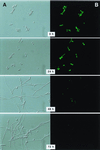Phenotypic variation and intracellular parasitism by histoplasma Capsulatum
- PMID: 10922037
- PMCID: PMC34014
- DOI: 10.1073/pnas.97.16.8794
Phenotypic variation and intracellular parasitism by histoplasma Capsulatum
Abstract
The success of Histoplasma capsulatum as an intracellular pathogen depends completely on successful conversion of the saprophytic mycelial (mold) form of this fungus to a parasitic yeast form. It is therefore not surprising that yeast phase-specific genes and gene products are proving to be important for survival and proliferation of H. capsulatum within macrophages. In this study, we have focused on the role and regulation of two yeast-specific characteristics: alpha-(1,3)-glucan, a cell wall polysaccharide modulated by cell-density (quorum) sensing, and a secreted calcium-binding protein (CBP) that is essential for pathogenicity.
Figures




Similar articles
-
Intracellular parasitism by Histoplasma capsulatum: fungal virulence and calcium dependence.Science. 2000 Nov 17;290(5495):1368-72. doi: 10.1126/science.290.5495.1368. Science. 2000. PMID: 11082066
-
Monitoring phase-specific gene expression in Histoplasma capsulatum with telomeric GFP fusion plasmids.Cell Microbiol. 2000 Dec;2(6):537-47. doi: 10.1046/j.1462-5822.2000.00078.x. Cell Microbiol. 2000. PMID: 11207606
-
The Eng1 β-Glucanase Enhances Histoplasma Virulence by Reducing β-Glucan Exposure.mBio. 2016 Apr 19;7(2):e01388-15. doi: 10.1128/mBio.01388-15. mBio. 2016. PMID: 27094334 Free PMC article.
-
Histoplasma capsulatum pathogenesis: making a lifestyle switch.Curr Opin Microbiol. 2008 Aug;11(4):318-24. doi: 10.1016/j.mib.2008.05.010. Epub 2008 Jun 21. Curr Opin Microbiol. 2008. PMID: 18573684 Review.
-
Histoplasma capsulatum molecular genetics, pathogenesis, and responsiveness to its environment.Fungal Genet Biol. 2002 Mar;35(2):81-97. doi: 10.1006/fgbi.2001.1311. Fungal Genet Biol. 2002. PMID: 11848673 Review.
Cited by
-
Information transmission in microbial and fungal communication: from classical to quantum.J Cell Commun Signal. 2018 Jun;12(2):491-502. doi: 10.1007/s12079-018-0462-6. Epub 2018 Feb 23. J Cell Commun Signal. 2018. PMID: 29476316 Free PMC article.
-
Quorum sensing-mediated, cell density-dependent regulation of growth and virulence in Cryptococcus neoformans.mBio. 2013 Dec 31;5(1):e00986-13. doi: 10.1128/mBio.00986-13. mBio. 2013. PMID: 24381301 Free PMC article.
-
Morphological transitions governed by density dependence and lipoxygenase activity in Aspergillus flavus.Appl Environ Microbiol. 2008 Sep;74(18):5674-85. doi: 10.1128/AEM.00565-08. Epub 2008 Jul 25. Appl Environ Microbiol. 2008. PMID: 18658287 Free PMC article.
-
On mechanism of quorum sensing in Candida albicans by 3(R)-hydroxy-tetradecaenoic acid.Curr Microbiol. 2011 Jan;62(1):55-63. doi: 10.1007/s00284-010-9666-6. Epub 2010 May 28. Curr Microbiol. 2011. PMID: 20509029
-
Bacterial Quorum Sensing and Microbial Community Interactions.mBio. 2018 May 22;9(3):e02331-17. doi: 10.1128/mBio.02331-17. mBio. 2018. PMID: 29789364 Free PMC article. Review.
References
-
- Eissenberg L G, Schlesinger P H, Goldman W E. J Leukocyte Biol. 1988;43:483–491. - PubMed
Publication types
MeSH terms
Substances
Grants and funding
LinkOut - more resources
Full Text Sources

